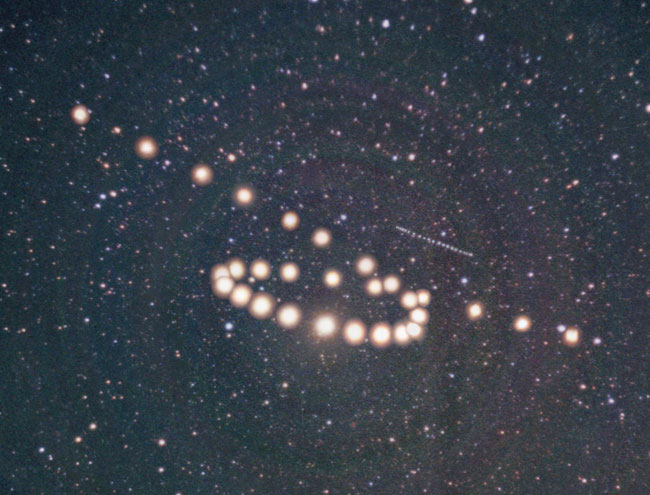
|
Credit & Copyright: Tunc Tezel
Explanation:
Why would Mars appear to move backwards?
Most of the time, the apparent motion of
Mars in
Earth's sky is in one direction,
slow but steady in front of the far distant stars.
About every two years, however, the
Earth passes Mars
as they orbit around the Sun.
During the most recent such pass in August,
Mars loomed particularly
large and bright.
Also during this time,
Mars appeared to move backwards in the sky,
a phenomenon called
retrograde motion.
Pictured above is a series of images digitally stacked
so that all of the stars images coincide.
Here, Mars appears to
trace out a loop in the sky.
At the top of the loop, Earth passed Mars and the
retrograde motion was the highest.
Retrograde motion can also be seen for other
Solar System planets.
In fact, by coincidence, the dotted line to the
right of the image center is Uranus
doing the same thing.
|
January February March April May June July August September October November December |
| ||||||||||||||||||||||||||||||||||||||||||||||||
NASA Web Site Statements, Warnings, and Disclaimers
NASA Official: Jay Norris. Specific rights apply.
A service of: LHEA at NASA / GSFC
& Michigan Tech. U.
Based on Astronomy Picture
Of the Day
Publications with keywords: Mars - retrograde motion
Publications with words: Mars - retrograde motion
See also:
- APOD: 2025 September 28 Á Leopard Spots on Martian Rocks
- APOD: 2025 July 15 Á Collapse in Hebes Chasma on Mars
- APOD: 2025 July 6 Á The Spiral North Pole of Mars
- APOD: 2025 June 29 Á Dark Sand Cascades on Mars
- APOD: 2025 June 22 Á A Berry Bowl of Martian Spherules
- APOD: 2025 June 15 Á Two Worlds One Sun
- Perseverance Selfie with Ingenuity
